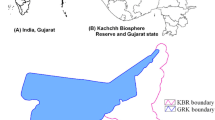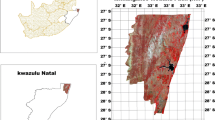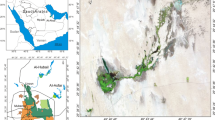Abstract
Monitoring wetland as one of the important parts of the global ecosystem is necessary for conservational programs. But, usually, collecting in situ data is restricted in these areas because of their remote locations, vast area and dynamic conditions. Remote sensing provides a cost effective tool to investigate hydrological patterns and the seasonal trend of changes in wetlands. In this paper, Land-use/land-cover change during water inundation period of Hamun wetland was investigated in order to determine change trend during this period. Hamun wetland is an unsustainable ecosystem, and monitoring this wetland is essential for conservation goals. This trend is critical for decision makers in order to plan the conservational scheme in all unsustainable ecosystems. To reach this objective, the land-use/land-cover maps during inundation period of Hamun were produced using Landsat 8 time series images. The results of accuracy assessment showed the classification of water and vegetation have the highest accuracy (94% and 93%, respectively). And the accuracy of plants in the water classes was the lowest (water–veg = 89.9%, veg–water 1 = 88.8%, veg–water 2 = 87.6%). This means the higher misclassification is in determining the vegetation in the water. Then, the changes in the land-cover classes in relation to wetland inundation were investigated. Results of land-use/land-cover change illustrate the regions that were suitable for water birds but lost their suitability when the wetland dried out. These areas are crucial for water bird’s conservation. Satellite data determined these areas with acceptable accuracy.





Similar content being viewed by others
References
Amiri, F., Rahdari, V., Maleki Najafabadi, S., Pradhan, B., & Tabatabaei, T. (2014). Multi-temporal landsat images based on eco-environmental change analysis in and around Chah Nimeh reservoir, Sistan and Balochestan (Iran). Environmental Earth Sciences, 72(3), 801–809.
Baghdadi, N., Bernier, M., Gauthier, R., & Neeson, I. (2001). Evaluation of C-band SAR data for wetlands mapping. International Journal of Remote Sensing, 22, 71–88.
Bayley, P. B. (1995). Understanding large river: Floodplain ecosystems. BioScience, 45, 153–158.
Berberoglu, S., Yilmaz, K. T., & Ozkan, C. (2004). Mapping and monitoring of coastal wetlands of Cukurova Delta in the Eastern Mediterranean region. Biodiversity and Conservation, 13, 615–633.
Bortels, L., Chan, J. C.-W., Merken, R., & Koedam, N. (2011). Long-term monitoring of wetlands along the Western-Greek Bird migration route using Landsat and ASTER satellite images: Amvrakikos Gulf (Greece). Journal for Nature Conservation, 19, 215–223.
Cardona, B. M., Ripolles, J., & Martinez, L. (2013). Wetland inundation monitoring by the synergistic use of ENVISAT/ASAR imagery and ancillary spatial data. Remote Sensing of Environment, 139, 171–184.
Carter, V. (2009). Remote sensing for wetland mapping and inventory. Water International, 6(4), 177–185.
Castaneda, C. J. H., Herrero, J., & Auxiliadora, C. (2005). Landsat monitoring of playa-lakes in the Spanish Monegros desert. Journal of Arid Environments, 63, 497–516.
Dahl, T. E. (2004). Remote sensing as a tool for monitoring wetland habitat change. In Monitoring science and technology symposium: Unifying knowledge or sustainability ill the western hemisphere.
Dong, Z., Wang, Z., Liu, D., Li, L., Ren, C., Tang, X., Jia, M., & Liu, C. (2013). Assessment of habitat suitability for waterbirds in the West Songnen Plain. Ecological Engineering, 55, 94–100.
Downard, R., Endter-Wada, J., & Kettenring, K. M. (2014). Adaptive wetland management in an uncertain and changing arid environment. Ecology and Society, 19(2), 23.
Feng, L., Chuanmin, H., Xiaoling, C., Xiaobin, C., Liqiao, T., & Wenxia, G. (2012). Assessment of inundation changes of Poyang Lake using MODIS observations between 2000 and 2010. Remote Sensing of Environment, 121, 80–92.
Feng, X. Q., Zhang, G. X., & Yin, X. R. (2010). Study on the hydrological responses to climate change in Wuyuer River Basin on the SWAT model. Progress in Geography, 29, 827–832.
Gao, B. C. (1996). NDWI—A normalized difference water index for remote sensing of vegetation liquid water from space. Remote Sensing of Environment, 58, 257–266.
Garcia, K., Lasco, R., Ines, A., Lyon, B., & Pulhin, F. (2013). Predicting geographic distribution and habitat suitability due to climate change of selected threatened forest tree species in the Philippines. Applied Geography, 44, 12–22.
Halls, A. J. (1997). Wetlands, biodiversity and the Ramsar convention: The role of the convention on 3 wetlands in the conservation and wise use of biodiversity. Gland: Ramsar Convention Bureau.
Huang, C., Peng, Y., Lang, M., Yeo, I.-Y., & McCarty, G. (2014). Wetland inundation mapping and change monitoring using Landsat and airborne LiDAR data. Remote Sensing of Environment, 141, 231–242.
Kassawmar, N. T., Rao, K. R. M., & Abraha, G. L. (2011). An integrated approach for spatio-temporal variability analysis of wetlands: A case study of Abaya and Chamo lakes, Ethiopia. Environmental Monitoring and Assessment, 180, 313–324.
Kerr, P. C., Martyr, R. C., Donahue, A. S., Hope, M. E., Westerink, J. J., & Luettich, R. A. (2013). U.S. IOOS Coastal and ocean modeling tested: Evaluation of tide, wave, and hurricane surge response sensitivities to mesh resolution and friction in the Gulf of Mexico. Journal of Geophysical Research: Oceans, 118, 4633–4661.
Maleki, S., Soffianian, A. R., Koupaei, S. S., Saatchi, S., Pourmanafi, S., & Sheikholeslam, F. (2016). Habitat mapping as a tool for water birds conservation planning in an arid zone wetland: The case study Hamun wetland. Ecological Engineering, 95, 594–603.
Mwaniki, M. W., Moeller, M. S., Schellmann, G. (2015). A comparison of Landsat 8 (OLI) and Landsat 7 (ETM+) in mapping geology and visualising lineaments: A case study of central region Kenya. In: 36th international symposium on remote sensing of environment, Berlin, Germany.
Ozesmi, S. L., & Bauer, M. (2002). Satellite remote sensing of wetlands. Wetlands Ecology and Management, 10, 381–402.
Plug, L. J., Walls, C., & Scott, B. M. (2008). Tundra lake changes from 1978 to 2001 on the Tuktoyaktuk Peninsula, western Canadian Arctic. Geophysical Research Letters, 35, 03502.
Powell, S. L., Cohen, W. B., Healey, S. P., Kennedy, R. E., Moisen, G. G., & Pierce, K. B. (2010). Quantification of live aboveground forest biomass dynamics with Landsat time-series and field inventory data: A comparison of empirical modeling approaches. Remote Sensing of Environment, 114, 1053–1068.
Rahdari, V., Maleki Najafabadi, S., Afsari, K. H., Abtin, E., & Piri, H. (2012). Change detection of Hmoun wild life refuge using RS & GIS. Remote sensing and GIS Journal, 3(2), 5970.
Rogers, A. S., & Kearney, M. S. (2004). Reducing signature variability in unmixing coastal marsh Thematic Mapper scenes using spectral indices. International Journal of Remote Sensing, 25, 2317–2335.
Roy, D., Kovalskyy, V., Zhang, H. K., Vermote, E. F., Yan, L., Kumar, S. S., et al. (2016). Characterization of Landsat-7 to Landsat-8 reflective wavelength and normalized difference vegetation index continuity. Remote Sensing of Environment, 185, 57–70.
Ruan, R., Feng, X., & She, Y. (2007). Fusion of RADARSAT SAR and ETM + imagery for identification of fresh waterwetland. In Proceedings of the SPIE 6752 (pp. 675221–675231). Nanjing: China.
Shamohammadi, Z., & Maleki, S. (2011). The Life of human. Yazd: Jahad Daneshgahi.
Thomas, R. F., Kingsford, R. T., Lu, Y., & Hunter, S. J. (2011). Landsat mapping of annual inundation (1979–2006) of the Macquarie Marshes in semi-arid Australia. International Journal of Remote Sensing, 32, 4545–4569.
Thorley, N., Clandillon, S., & Fraipont, P. De. (1997). The contribution of space borne SAR and optical data in5 monitoring flood events: Examples in northern and southern France. Hydrological Processes, 11, 1409–1413.
Widis, D. C., BenDor, T. K., & Deegan, M. (2015). Prioritizing Wetland Restoration Sites: A review and application to a large-scale coastal restoration program. Ecological Restoration., 33(4), 358–377.
Zhang, L., Yang, J., Li, P., & Zhang, L. (2014). Seasonal inundation monitoring and vegetation pattern6 mapping of the Erguna floodplain by means of a RADARSAT-2 fully polarimetric time series. Remote Sensing of Environment, 152, 426–440.
Author information
Authors and Affiliations
Corresponding author
About this article
Cite this article
Maleki, S., Soffianian, A., Soltani Koupaei, S. et al. Application of Remote Sensing in Monitoring Unsustainable Wetlands: Case Study Hamun Wetland. J Indian Soc Remote Sens 46, 1871–1879 (2018). https://doi.org/10.1007/s12524-018-0842-7
Received:
Accepted:
Published:
Issue Date:
DOI: https://doi.org/10.1007/s12524-018-0842-7




